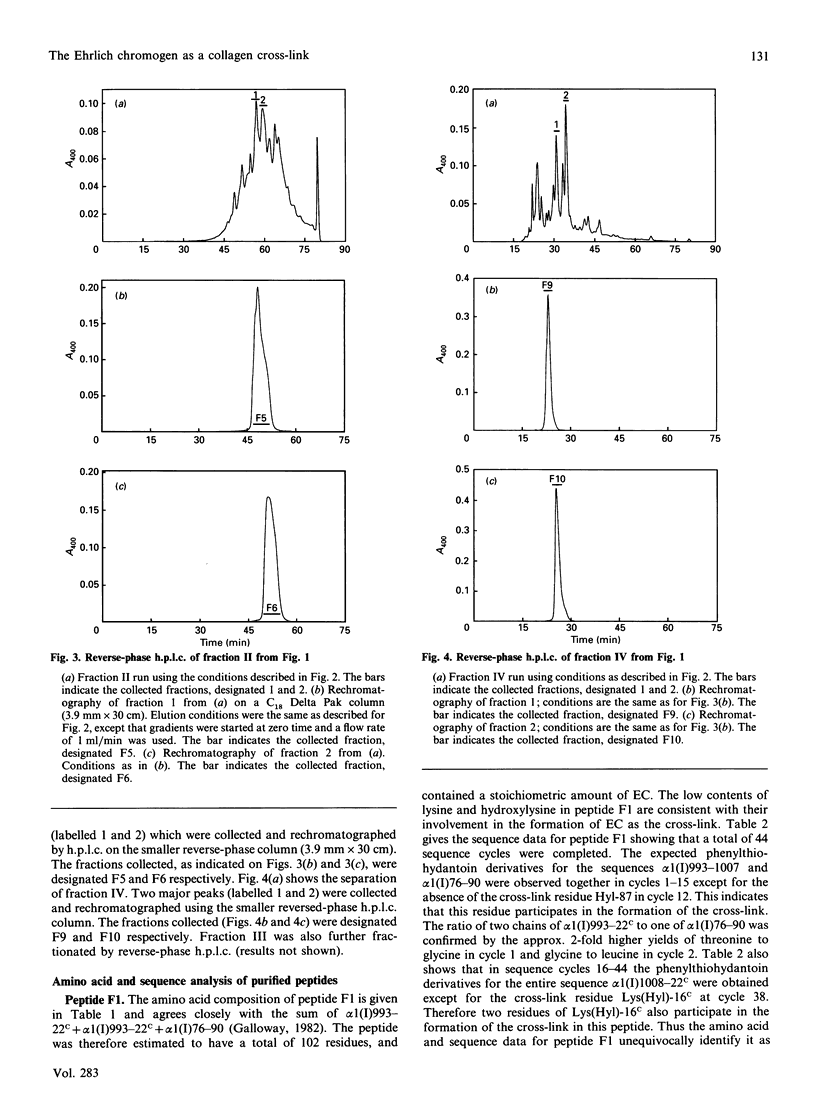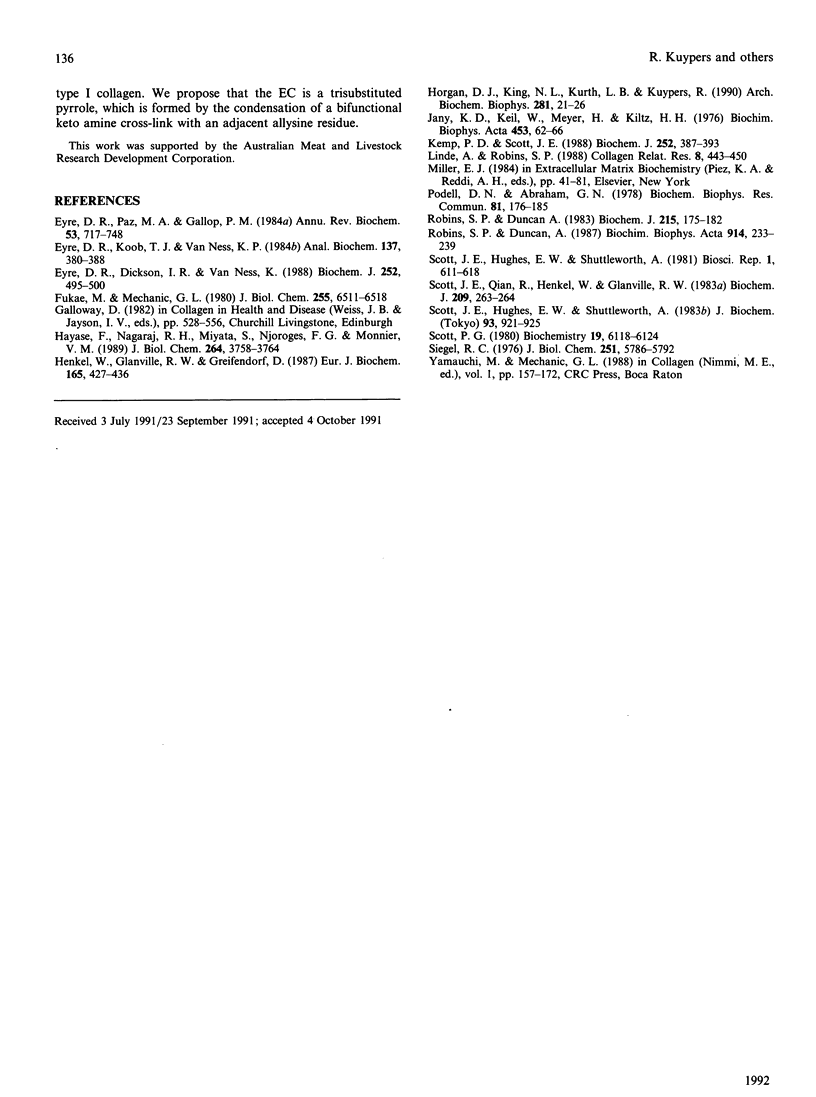Abstract
Collagenous peptides containing the Ehrlich chromogen (EC) were selectively isolated from a tryptic digest of bovine tendon by coupling to a diazotized polyacrylamide support. The isolated p-phenol-azo-EC peptides were purified and characterized by amino acid and sequence analyses. EC occurred in stoichiometric amounts in trimeric cross-linked chains originating from the known cross-link regions of type-I collagen. The major locus of the EC was alpha 2(I)Hyl-933 x alpha 1(I)Lys(Hyl)-9N x alpha 2(I)Lys(Hyl)-5N but it was also shown to occur at the loci alpha 1(I)Hyl-87 x alpha 1(I)Lys(Hyl)-16C x alpha 1(I)Lys(Hyl)-16C and alpha 1(I)Hyl-930 x alpha 1(I)Lys(Hyl)-9N x alpha 2(I)Lys(Hyl)-5N. After sequence analyses of the C-terminal helical cross-link region alpha 2(I)928-963, corrections are presented for residues 927, 930, 932 and 933 of the bovine alpha 2(I) chain. The collagen-associated EC is postulated to be a trisubstituted pyrrole formed by the reaction of the aldehyde form of a telopeptidyl lysine residue with a bifunctional keto amino cross-link. It is also proposed that when the telopeptidyl lysine residue is hydroxylated the above reaction will result in pyridinoline formation.
Full text
PDF







Selected References
These references are in PubMed. This may not be the complete list of references from this article.
- Eyre D. R., Dickson I. R., Van Ness K. Collagen cross-linking in human bone and articular cartilage. Age-related changes in the content of mature hydroxypyridinium residues. Biochem J. 1988 Jun 1;252(2):495–500. doi: 10.1042/bj2520495. [DOI] [PMC free article] [PubMed] [Google Scholar]
- Eyre D. R., Koob T. J., Van Ness K. P. Quantitation of hydroxypyridinium crosslinks in collagen by high-performance liquid chromatography. Anal Biochem. 1984 Mar;137(2):380–388. doi: 10.1016/0003-2697(84)90101-5. [DOI] [PubMed] [Google Scholar]
- Eyre D. R., Paz M. A., Gallop P. M. Cross-linking in collagen and elastin. Annu Rev Biochem. 1984;53:717–748. doi: 10.1146/annurev.bi.53.070184.003441. [DOI] [PubMed] [Google Scholar]
- Fukae M., Mechanic G. L. Maturation of collagenous tissue. Temporal sequence of formation of peptidyl lysine-derived cross-linking aldehydes and cross-links in collagen. J Biol Chem. 1980 Jul 10;255(13):6511–6518. [PubMed] [Google Scholar]
- Hayase F., Nagaraj R. H., Miyata S., Njoroge F. G., Monnier V. M. Aging of proteins: immunological detection of a glucose-derived pyrrole formed during maillard reaction in vivo. J Biol Chem. 1989 Mar 5;264(7):3758–3764. [PubMed] [Google Scholar]
- Henkel W., Glanville R. W., Greifendorf D. Characterisation of a type-I collagen trimeric cross-linked peptide from calf aorta and its cross-linked structure. Detection of pyridinoline by time-of-flight secondary ion-mass spectroscopy and evidence for a new cross-link. Eur J Biochem. 1987 Jun 1;165(2):427–436. doi: 10.1111/j.1432-1033.1987.tb11456.x. [DOI] [PubMed] [Google Scholar]
- Horgan D. J., King N. L., Kurth L. B., Kuypers R. Collagen crosslinks and their relationship to the thermal properties of calf tendons. Arch Biochem Biophys. 1990 Aug 15;281(1):21–26. doi: 10.1016/0003-9861(90)90407-p. [DOI] [PubMed] [Google Scholar]
- Jany K. D., Keil W., Meyer H., Kiltz H. H. Preparation of a highly purified bovine trypsin for use in protein sequence analysis. Biochim Biophys Acta. 1976 Nov 26;453(1):62–66. doi: 10.1016/0005-2795(76)90250-6. [DOI] [PubMed] [Google Scholar]
- Kemp P. D., Scott J. E. Ehrlich chromogens, probable cross-links in elastin and collagen. Biochem J. 1988 Jun 1;252(2):387–393. doi: 10.1042/bj2520387. [DOI] [PMC free article] [PubMed] [Google Scholar]
- Linde A., Robins S. P. Quantitative assessment of collagen crosslinks in dissected predentin and dentin. Coll Relat Res. 1988 Sep;8(5):443–450. doi: 10.1016/s0174-173x(88)80017-7. [DOI] [PubMed] [Google Scholar]
- Podell D. N., Abraham G. N. A technique for the removal of pyroglutamic acid from the amino terminus of proteins using calf liver pyroglutamate amino peptidase. Biochem Biophys Res Commun. 1978 Mar 15;81(1):176–185. doi: 10.1016/0006-291x(78)91646-7. [DOI] [PubMed] [Google Scholar]
- Robins S. P., Duncan A. Cross-linking of collagen. Location of pyridinoline in bovine articular cartilage at two sites of the molecule. Biochem J. 1983 Oct 1;215(1):175–182. doi: 10.1042/bj2150175. [DOI] [PMC free article] [PubMed] [Google Scholar]
- Robins S. P., Duncan A. Pyridinium crosslinks of bone collagen and their location in peptides isolated from rat femur. Biochim Biophys Acta. 1987 Aug 21;914(3):233–239. doi: 10.1016/0167-4838(87)90282-2. [DOI] [PubMed] [Google Scholar]
- Scott J. E., Hughes E. W., Shuttleworth A. An 'affinity' method for preparing polypeptides enriched in the collagen-associated Ehrlich chromogen. J Biochem. 1983 Mar;93(3):921–925. doi: 10.1093/jb/93.3.921. [DOI] [PubMed] [Google Scholar]
- Scott J. E., Qian R., Henkel W., Glanville R. W. An Ehrlich chromogen in collagen cross-links. Biochem J. 1983 Jan 1;209(1):263–264. doi: 10.1042/bj2090263. [DOI] [PMC free article] [PubMed] [Google Scholar]
- Scott P. G. A major intermolecular cross-linking site in bovine dentine collagen involving the alpha 2 chain and stabilizing the 4D overlap. Biochemistry. 1980 Dec 23;19(26):6118–6124. doi: 10.1021/bi00567a026. [DOI] [PubMed] [Google Scholar]
- Siegel R. C. Collagen cross-linking. Synthesis of collagen cross-links in vitro with highly purified lysyl oxidase. J Biol Chem. 1976 Sep 25;251(18):5786–5792. [PubMed] [Google Scholar]


